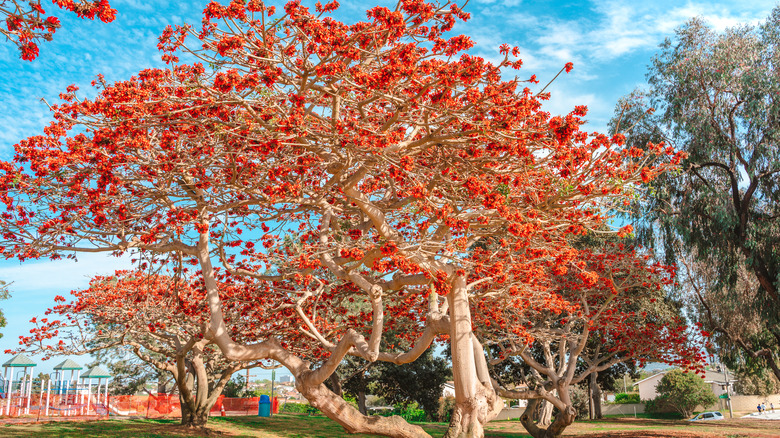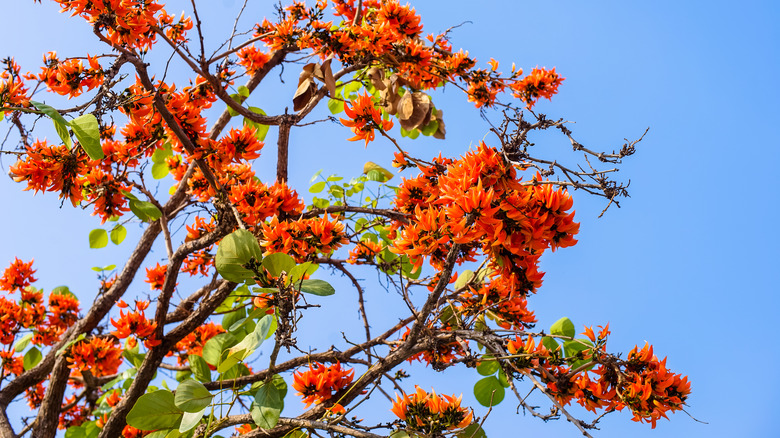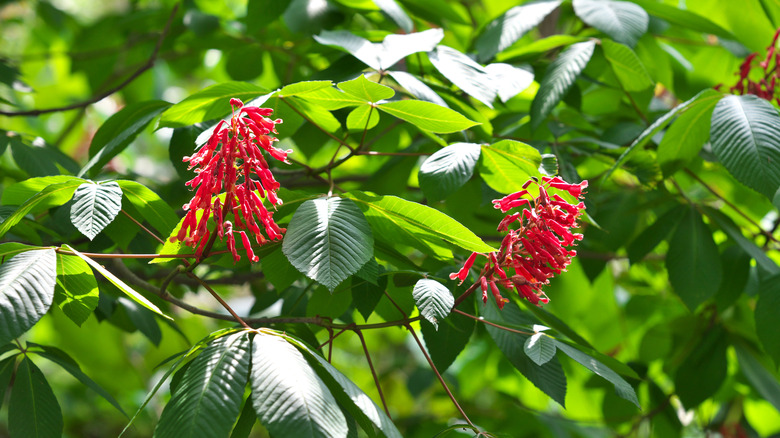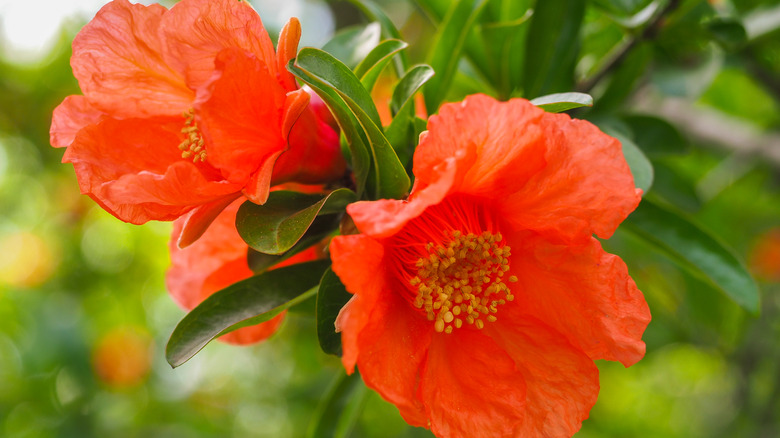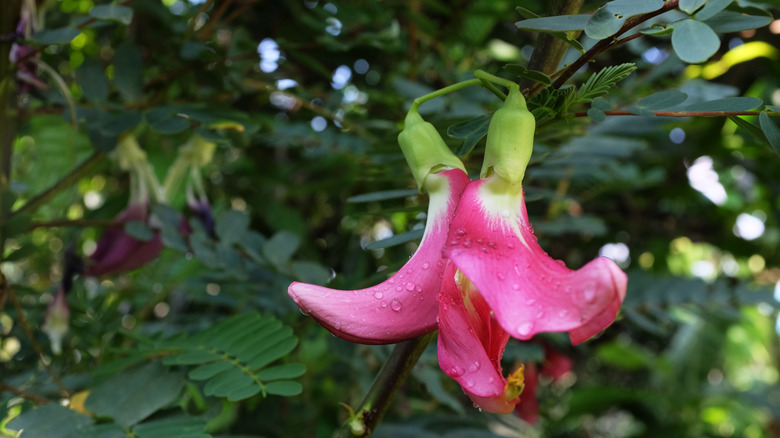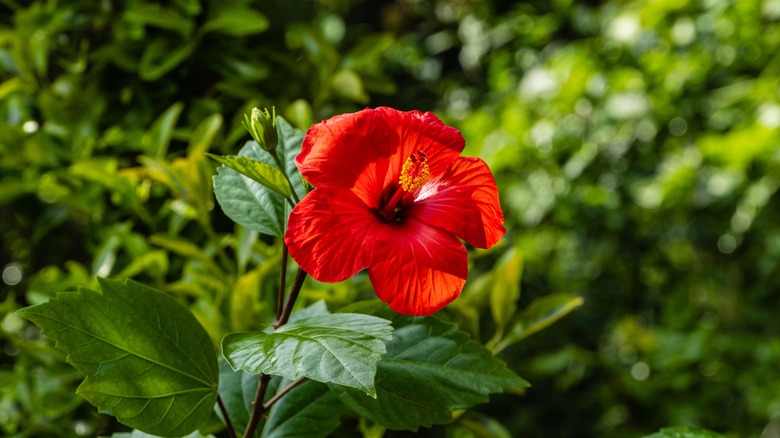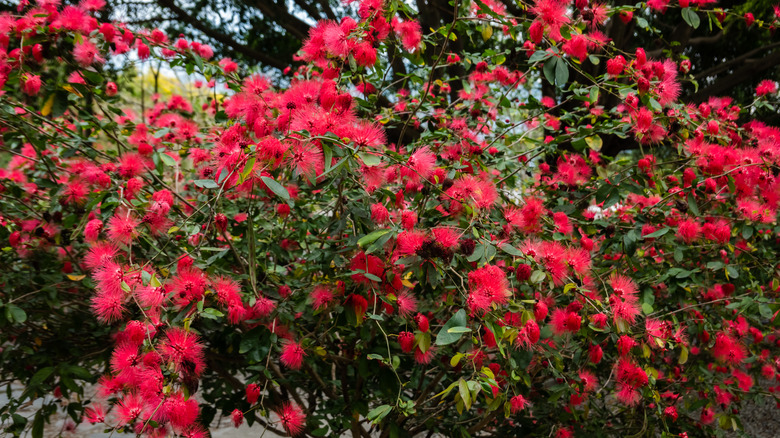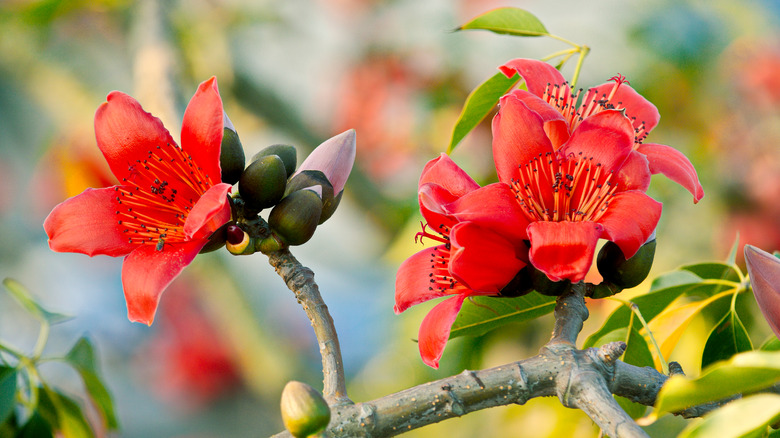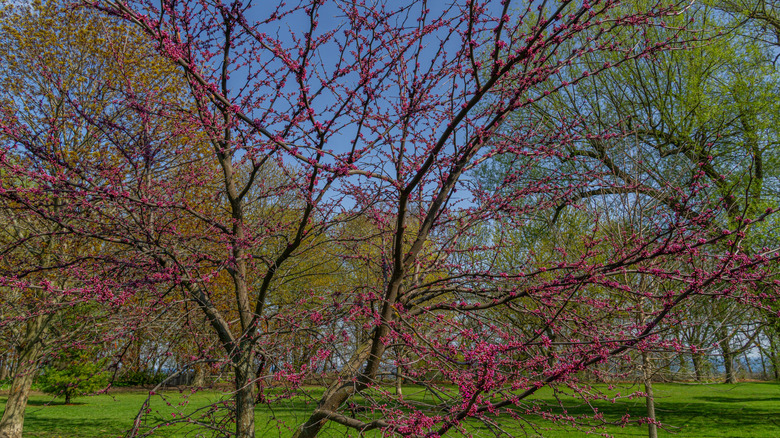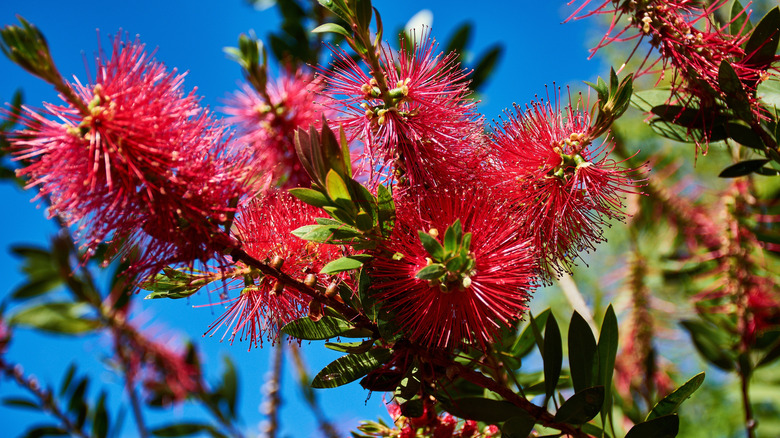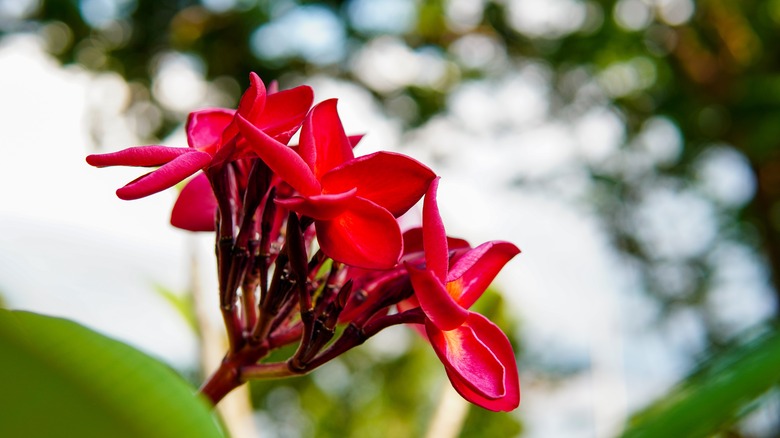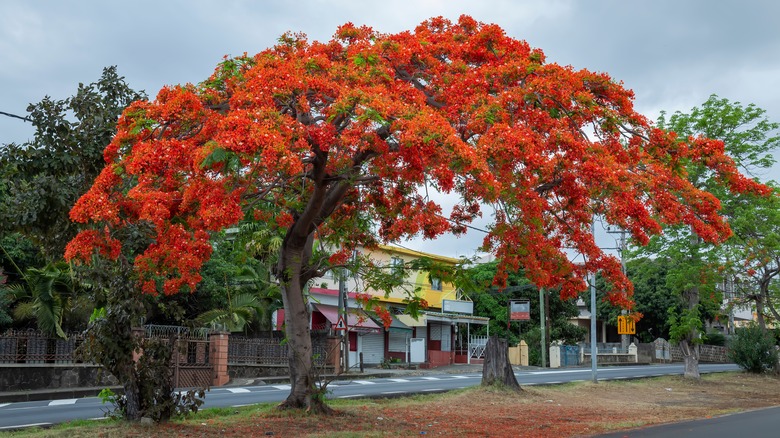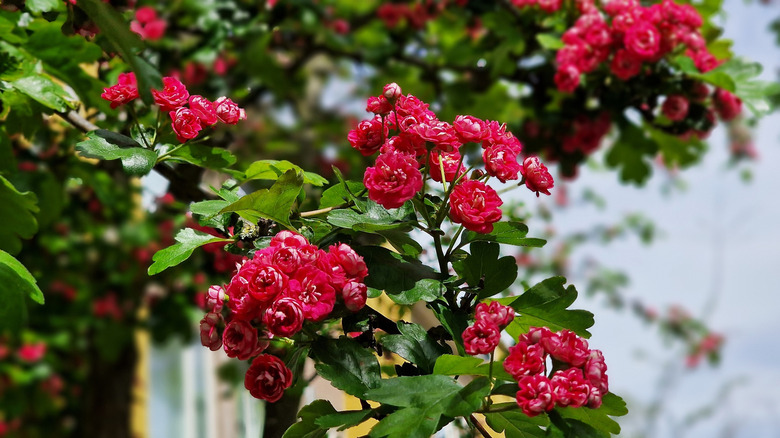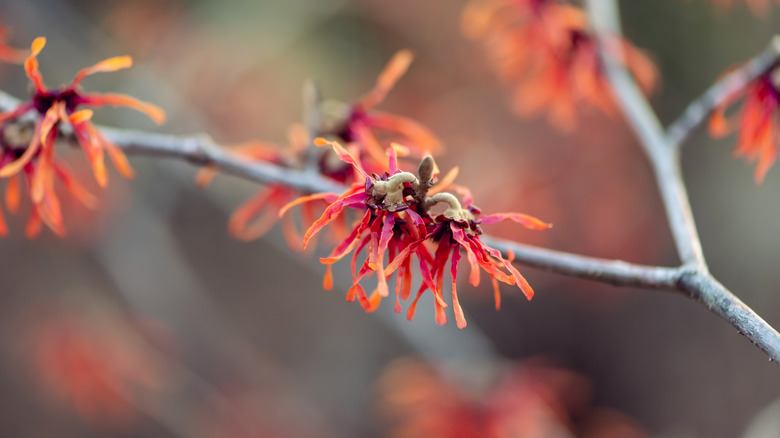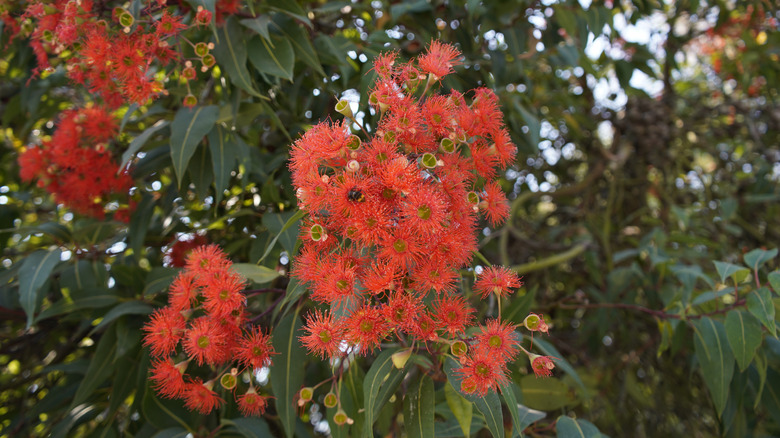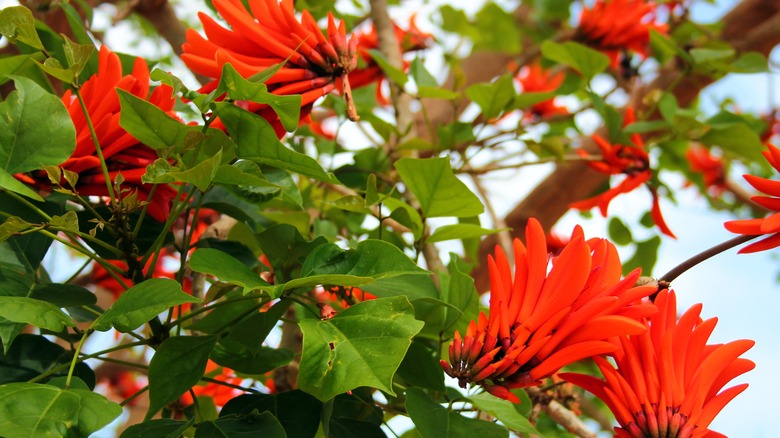15 Trees That Bloom With Gorgeous Red Flowers
Is red your color? In a landscape, the typical red tulips, rose bushes, and carnations might not be enough to satiate your craving for carmine and crimson. If you're looking for something bigger and better, consider red flowering trees for more height variation and, often, larger blooms — as is the case with the red silk cotton tree. On the other hand, if your yard can only accommodate a small tree that won't overtake your yard, consider a tree-like shrub, such as the red buckeye tree.
Red flowering trees are not few and far between for those who live in warm and tropical climates, but states further North might have trouble finding an option they like that's also a good fit for their climate. Make sure that you consider your USDA hardiness zone, growing conditions, soil type, and the size of your property before planting. This way, you can be positive that your tree will grow successfully for as long as possible. Now, let's change up the look of your lawn or garden with one or more of these 15 trees.
1. Flame of the forest
Flame of the forest (Butea monosperma) is a tree that grows in warm, humid climates in USDA hardiness zones 10 to 12. A deciduous species, it sheds large, leathery green leaves at the beginning of winter, which are replaced in January with bright red-orange blooms that form racemes of up to 6 inches long. Plant flame-of-the-forest as a specimen tree in your yard or grow it alongside other tree species in a mixed grove.
2. Red buckeye
Native to the southeastern United States, red buckeye (Aesculus pavia) is a tree that can also be grown as a shrub, most often reaching only 15 to 20 feet tall at maturity. In zones 4 to 9, including North Carolina, Illinois, Texas, and Florida, this tree thrives in deep and well-draining soil. Keep the soil evenly moist, and the scarlet buckeye tree will produce tubular flowers that attract ruby-throated hummingbirds during spring migration.
3. Pomegranate tree
Pomegranate trees (Punica granatum) offer more than their iconic, compartmentalized fruits; they also bring beautiful, bright red flowers with petals like crepe paper. These trees produce the best fruit and flowers when grown in hot, arid climates with long summers, particularly in USDA zones 8 to 11. Expect to see first blooms in mid-summer and more throughout the growing season until fall. Pomegranate trees cannot survive winter temperatures that drop below 10 degrees Fahrenheit, so you should be familiar with your zone before planting.
4. Vegetable hummingbird tree
Vegetable hummingbird tree (Sesbania grandiflora var. coccinea), also known as West Indian pea, is a popular tree with widespread growth in South and Southeast Asian countries. It has unique, pinkish-red flowers, but that's not the only reason people love this tree; plants in the Sesbania genus are also known for their nitrogen-fixing abilities. Today, it is grown across the Neotropical realm, but not always for the right reasons. Despite its beauty, you might reconsider planting a hummingbird tree in the ground as the University of Florida has predicted it to have a high invasion risk.
5. Tropical hibiscus
Tropical hibiscus (Hibiscus rosa-sinensis), aka Chinese hibiscus, is actually an evergreen shrub that can grow up to 10 feet tall, resembling a small tree. There are many colorful varieties of hibiscus flowers for a tropical garden that stand out – even a few different shades of red. As its name suggests, tropical hibiscus is native to China and other parts of tropical Southeast Asia. It grows in rich and moist soil in USDA zones 9 to 12.
6. Red powder puff
The red powder puff tree (Calliandra haematocephala) is a broadleaf evergreen with an affinity for hot and humid climates. It has naturalized in central and southern Florida and can be grown anywhere inside USDA zones 9 to 11–but watch out for aggressive growth and trim as needed. Ensure your yard has sufficient space for it before planting, as the red powder puff tree can grow up to 15 feet tall in ideal conditions. The spiky blooms are made almost entirely from long stamens that create the "puff" and add a bright red color to your yard that attracts hummingbirds.
7. Red silk cotton tree
The tallest flowering tree on our list is the red silk cotton tree (Bombax ceiba), which frequently grows up to 70 feet — or taller in the proper conditions. Its height isn't the only thing large about it either; in spring, the tree is dotted with red-orange flowers, often 6 to 8 inches in diameter. The red silk cotton tree is also naturally adaptable, being native to tropical monsoon climates, and can be grown in USDA hardiness zones 10 to 12.
8. Eastern redbud
Although its flowers tend to lean toward the pinker side of the red spectrum, the Eastern redbud (Cercis canadensis) is a Midwestern classic that simply cannot be skipped. If you live in cooler zones 4 to 9, this vibrant tree will bring stunning color to your spring landscape. Expect Eastern redbud to bloom early in the spring, with white to red flowers, depending on the variety.
9. Crimson bottlebrush
Crimson bottlebrush (Melaleuca citrina) is named for its cylindrical flower spikes that resemble the dishwashing tool for cleaning water bottles. Native to Australia, you must live in a warm climate to grow and care for a bottlebrush tree, which is really an upright tropical shrub. In zones 9 and 10, it should be planted in fertile soil with regular watering until it grows into an established plant. The crimson bottlebrush has been introduced in Louisiana and California.
10. Red frangipani tree
If you want a sweet fragrance in addition to showy red blooms, the red frangipani tree (Plumeria rubra) is the perfect specimen for your front lawn. It grows into a medium-sized, 20- to 25-foot-tall tree with long, dark green leaves and blooms that last for most of the year when grown in the proper conditions. Hardy to USDA zones 10 to 12, this popular tree is often grown in Southern California and Florida, but if you plant your plumeria tree in a container, it'll be living its best life.
11. Royal poinciana tree
The royal poinciana tree (Delonix regia) is native to Madagascar but can be grown in the southern parts of warmer U.S. states, like Texas, Hawaii, California, Florida, and Arizona, in USDA zones 10 through 12. It grows to about 40 feet tall in proper conditions and usually has an even wider spread. The tree will add a bold pop of color to your yard when its canopy explodes with red flowers in the early days of summer, but they die back within a couple of months.
12. English hawthorn tree
English hawthorn tree (Crataegus laevigata) varieties typically bloom with pink or white flowers, but 'Crimson Cloud' and 'Paul's Scarlet' cultivars offer bright red petals perfect for classic garden designs. As a member of the Rosaceae family, some varieties' blooms can bear a striking resemblance to roses, while others offer single, star-shaped flowers. People in cooler climates can grow English hawthorn trees as they are hardy to USDA zones 4 through 8.
13. Hybrid witch hazel
Another cold-hardy, red-flowering tree is the hybrid witch hazel (Hamamelis x intermedia), a cross between Chinese witch hazel (Hamamelis mollis) and Japanese witch hazel (Hamamelis japonica), which can grow in zones 5 to 9. The hybrid species has many different varieties, a few of which feature flowers with red and reddish bi-colored petals, such as 'Diane,' 'Aphrodite,' and 'Ruby Glow.' While these varieties are generally unscented, there are also hybrid witch hazels with fragrant and mildly fragrant blossoms.
14. Red flowering gum
If you live on the West Coast, you've likely seen a red flowering gum tree (Corymbia ficifolia) — maybe you have one growing in your yard right now! Although these trees are native to Western Australia, they grow just as well on California's coastline, where they enjoy bright sunlight and tolerate drought and pollution. The trees typically bloom at the end of summer, with clusters of red flowers that bees and other pollinators find attractive.
15. Indian coral tree
A member of the Legume family, the Indian coral tree (Erythrina Variegata) shares many similar characteristics with its distant relative: the vegetable hummingbird tree. It has long, red, crescent-shaped flowers, thrives in humid environments, and is a nitrogen-fixing plant. Indian coral trees can be grown in zones 10 to 11–aka warm climates, including in Florida, California, and Arizona–but keep in mind that they are reportedly invasive in Hawaii in Haleakala National Park.
